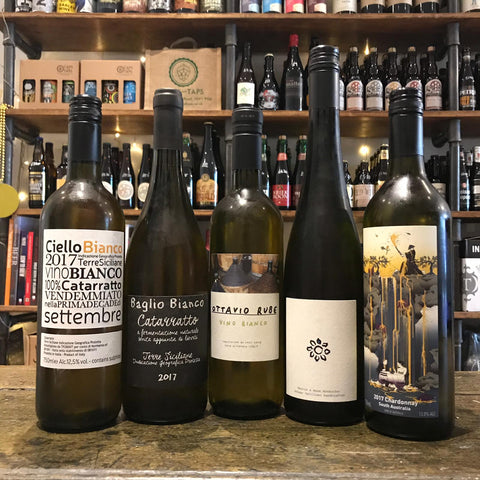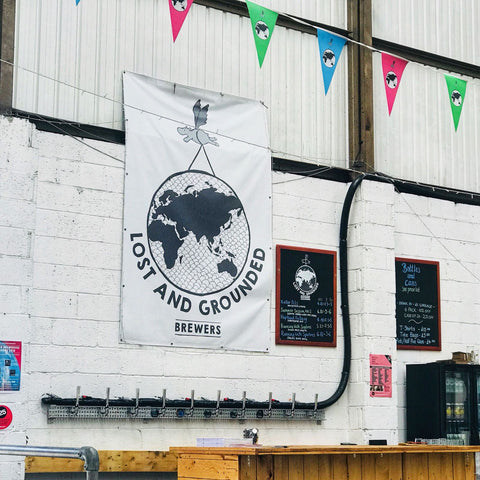We’ve got 16 super exciting new natural wines in the shop this winter to revamp our range: 3 sparkling, 4 whites, 1 orange and 8 reds. Since a few have some pretty unusual grape varieties, we thought it might be nice to run you through them… First up we’ll be introducing the sparkling, whites and orange wines, then in the next post we’ll meet the reds.
Before we get into the details though, let’s start with the basics - what is ‘natural wine’? Well, just like craft beer, this term is still the subject of much debate, but as a general rule they tend to be wines made with low intervention in both the vineyard and winery. This means that the grapes are often organic, or at least grown with minimal pesticides, and once they get to the winery the winemaker tries to do as little as possible to still get a delicious wine at the end! This can mean using wild rather than commercial yeast, trying not to use preservatives or additives (like sulphur), minimising chemicals used throughout the winery, and often trying to let the grapes shine by themselves by using little to no oak.
BUBBLES

Starting with our bubbly, we’ve got two Proseccos and a Cava to set you up for Christmas. Our first Prosecco, the Bernardi Prosecco DOC Frizzante NV is a very typical lightly-sparkling Prosecco with almond, pear and honeysuckle on the nose, following through to traditional apple and quince on the palate. The Bellenda San Fermo Prosecco Superiore 2017 is really Prosecco masquerading as Champagne, with a much more mineral, toasted walnut palate, and a continuous bead of fine bubbles. Although it is made in the traditional Prosecco method, it has an additional stage of ageing on lees (dead yeast), like Champagne, leading to nutty, rather than apple flavours.
Our third sparkling wine is the Dominio de Tharsys Cava Brut NV, an organic Cava made from Macabeo and Parellada grapes, two of the three traditional Cava grape varieties. Dominio de Tharsys is widely recognised as one of the top Cava producers, and owner Vicente Garcia known as the “godfather of Valencian cava”. Drier than Prosecco, Cava is made using the same method as Champagne, but rather than nutty and bready, this is a fresh, floral wine with notes of banana and citrus on the palate and well-balanced acidity.
WHITE & ORANGE
 Moving onto the still wines, the eagle-eyed among you might be able to spot in the photo that we have two wines that seem pretty similar - both made from the Cattaratto grape variety, and both from Sicily - so what makes them different? Well, one is white (Ciello Bianco Catarratto 2017) and one is orange (Baglio Bianco Catarratto 2017). So what’s an orange wine? Simply put, it’s a wine made from white grapes but in the same way you normally make red wine (and sometimes rosé, just to confuse things). This means using white grapes, but rather than pressing the juice from the grapes and just fermenting that, you keep the grape skins in the mix, imparting both colour and tannins. The result? Wines with a deeper colour and more texture, thanks to the tannins (the stuff that can coat your tongue when you drink red wine!).
Moving onto the still wines, the eagle-eyed among you might be able to spot in the photo that we have two wines that seem pretty similar - both made from the Cattaratto grape variety, and both from Sicily - so what makes them different? Well, one is white (Ciello Bianco Catarratto 2017) and one is orange (Baglio Bianco Catarratto 2017). So what’s an orange wine? Simply put, it’s a wine made from white grapes but in the same way you normally make red wine (and sometimes rosé, just to confuse things). This means using white grapes, but rather than pressing the juice from the grapes and just fermenting that, you keep the grape skins in the mix, imparting both colour and tannins. The result? Wines with a deeper colour and more texture, thanks to the tannins (the stuff that can coat your tongue when you drink red wine!).
White or orange, Catarratto is a great food wine because of its high acidity and tannins (it’s the house white at Franco Manca, Theo’s Pizzeria etc. etc.). Ciello Bianco is very aromatic, full of apricot and quince, great with fish or light pasta dishes, whilst Baglio Bianco is a bit richer and spicier, with red plums and apples on the nose, perfect with pork or poultry, or of course pizza.
Valli Unite Ottavio Rube Vino Bianco throws up two more lesser-known grape varieties - Cortese and Timorasso. Both of these are indigenous grapes native to the Piedmont region of northern Italy, where this wine comes from. Timorasso is a very interesting variety, being both one of the rarest (only 50 hectares planted, all in Piedmont) and one of the oldest, dating from Roman times. Valli Unite is a little co-op of 30 people, farming 100 hectares that has been managed organically since 1981, and not just grapes - it also has bees, pigs and cattle! This no-added sulphur wine has some yellow plum fruit but really it’s all about herbs and savouriness. This extra complexity means that as well as chicken, it could also take on some pretty fancy seafood dishes or cheese, which despite popular belief is not always such a straightforward match!
A particularly recent addition to our range is the M & A Arndorfer Gruner Handcrafted 2017. This sustainably-grown Austrian Gruner Veltliner comes from a single vineyard in the Alps, so mountainous that it is too cold to grow grapes just 15km away! Despite this, this is a rich and complex wine, with baked apple and peach aromas, but heaps of acidity keeping it ultra-fresh. More unusually for natural wine (especially whites), this is made to age up to 5 years, although it is tasting brilliant already, on its own or with vegetable-based pasta dishes.
Lastly we have Samurai Chardonnay 2017 from Free Run Juice - finally a recognisable grape variety! This has got typical Chardonnay aromas of peach and melon, but don’t worry ABC-ers (that’s Anything But Chardonnay), this isn’t a big rich Chardonnay. Because the grapes are grown in South Australia, where it’s a bit cooler, this has got a decent whack of acidity, which combined with a lack of oak ageing makes it fresh and fruity rather than flabby.
Look out for our next post on our new red wines!


